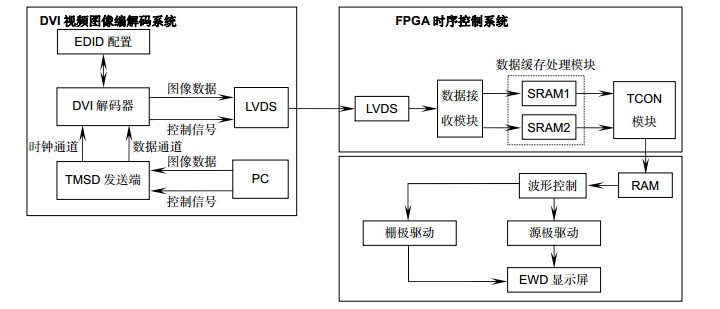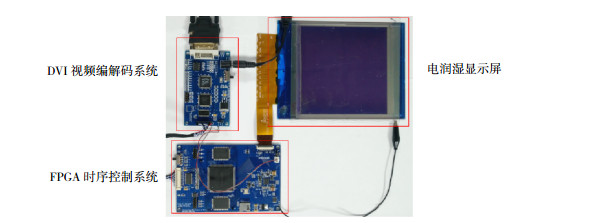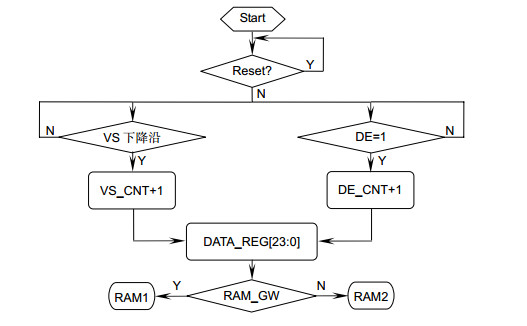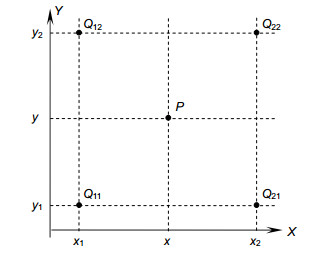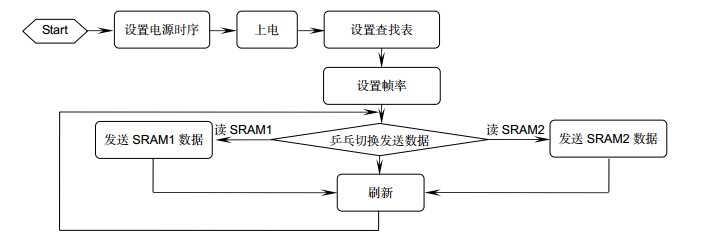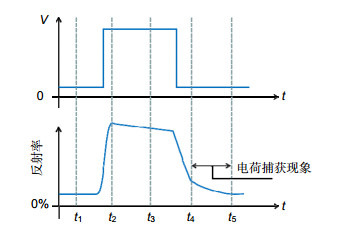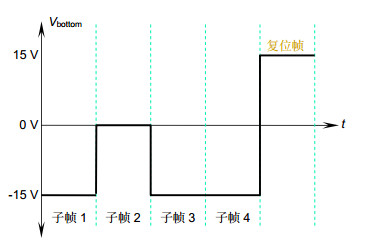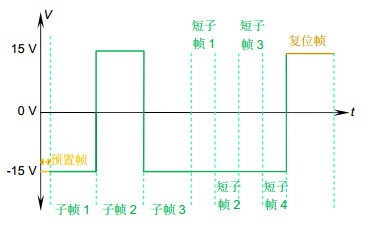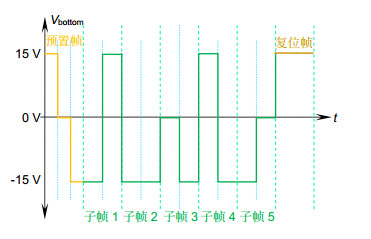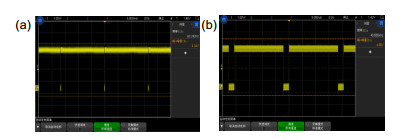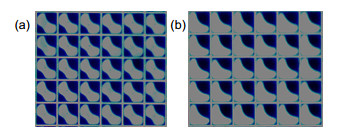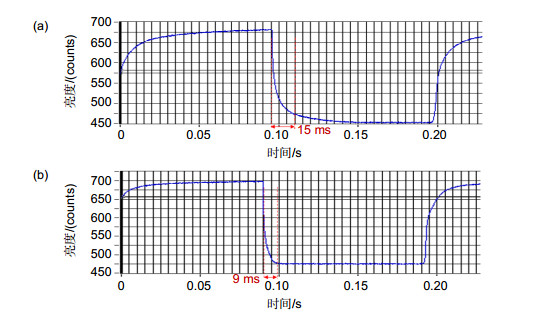-
摘要
为了实现电润湿电子纸显示器实时播放视频,本文设计了DVI视频图像编解码系统加上FPGA时序控制的显示驱动系统。DVI系统负责获取信号源并进行图像编解码,FPGA负责视频图像数据的缓存处理以及驱动波形的控制。本文提出的多灰度动态对称驱动波形,可改善油墨分裂现象,并且在增加灰度等级的同时抑制电荷捕获现象。实验表明:该系统成功改善了油墨分裂、电荷捕获等问题,成功驱动1024x768分辨率的电润湿显示器跟随PC端进行实时视频播放,视频的帧率达到60帧/秒,像素的最高灰度达到15阶,满足电润湿电子纸动态显示视频的要求。
Abstract
In order to achieve electrowetting real-time display, a display driving system, consisting of a DVI video codec system and FPGA timing control system, is designed. DVI video codec system is responsible for obtaining signal sources and for image coding and decoding. FPGA is responsible for buffering and processing of video data and for controlling electrowetting driving waveforms. This paper also proposes an improved multi-grayscales dynamic symmetrical driving waveform, which improves the ink-splitting phenomenon and suppresses the charge-trapping phenomenon while increasing the gray level. The results show that the driving system successfully improves the problems of oil-splitting and charge-trapping, and drives the 1024x768 resolution electrowetting display to play video in real time following the computer. The frame rate of the video reaches 60 frames/second, and the highest gray level of the pixel reaches 15. These properties meet the requirements for dynamic display of the electrowetting paper.
-
Key words:
- electrowetting display /
- display driving system /
- real-time /
- FPGA /
- DVI
-
Overview

Overview:Electrowetting display is a new type of paper-like display, which has the characteristics of low power consumption, high contrast, no radiation and easy colorization, and is one of the most promising display technologies in the future. In order to play video in real time of electrowetting display, a display driving system which includes a DVI video codec system and FPGA timing control system is designed. The DVI system is responsible for acquiring the signal source, for performing image encoding and decoding, and for obtaining all kinds of various resolution videos. The video source comes from the computer, and is not required to be stored. The operation is simple and convenient. Dual-link DVI system supports to transfer ultra-high resolution video, and the system is suitable for electrowetting display panels with increasing resolution at later stages. FPGA is responsible for buffering and processing of video data and for controlling electrowetting driving waveforms. FPGA can easily process video image data of various resolutions due to its powerful and high-speed data parallel processing capability. The driving waveform for electrowetting is also controlled by FPGA without other waveform generator devices, which is more conducive to the development of the driving system into a portable device. In terms of driving waveform, the ordinary multi-gray electrowetting driving waveform can display the image of 9th gray scale, but the ink is prone to splitting under the driving voltage. The charge trapping phenomenon is serious. The ink-splitting phenomenon can decrease the aperture ratio and brightness of electrowetting display panels, and the charge-trapping phenomenon would increase the close response time of the ink and reduce the frame rate, which is not conductive to play video. This paper also proposes an improved multi-grayscales dynamic symmetrical driving waveform, which improves the ink-splitting phenomenon and suppresses the charge-trapping phenomenon while increasing the gray level. The results show that the driving system successfully improves the problems of oil-splitting and charge-trapping, and drives the 1024x768 resolution electrowetting display to play video in real time following the computer. The frame rate of the video reaches 60 frames/second, and the highest gray level of the pixel reaches 15. The video image has clear details, and the system transmission is stable. These properties meet the requirements for dynamic display of the electrowetting paper.
-

-
-
参考文献
[1] Hayes R A, Feenstra B J. Video-speed electronic paper based on electrowetting[J]. Nature, 2003, 425(6956): 383-385. doi: 10.1038/nature01988
[2] 段明正.电润湿电子纸的驱动波形和显示系统设计[D].广州: 华南师范大学, 2015.
Duan M Z. Driving waveform and display system design of electrowetting display[D]. Guangzhou: South China Normal University, 2015.
[3] Van Dijk R, Feenstra B J, Hayes R A, et al. 68. 3: Gray scales for video applications on electrowetting displays[J]. SID Symposium Digest of Technical Papers, 2006, 37(1): 1926-1929. doi: 10.1889/1.2433427
[4] Jung H Y, Choi U C, Park S H, et al. P-48: Development of driver IC with novel driving method for the electrowetting display[J]. SID Symposium Digest of Technical Papers, 2012, 43(1): 1239-1242. doi: 10.1002/j.2168-0159.2012.tb06022.x
[5] Zhang X M, Bai P F, Hayes R A, et al. Novel driving methods for manipulating oil motion in electrofluidic display pixels[J]. Journal of Display Technology, 2016, 12(2): 200-205. http://www.wanfangdata.com.cn/details/detail.do?_type=perio&id=b7cce66d2ef188d3e4d7ea5b51137625
[6] Chen Y C, Chiu Y H, Lee W Y, et al. 56.3: A charge trapping suppression method for quick response electrowetting displays[J]. SID Symposium Digest of Technical Papers, 2010, 41(1): 842-845. doi: 10.1889/1.3500607
[7] Yi Z C, Shui L L, Wang L, et al. A novel driver for active matrix electrowetting displays[J]. Displays, 2015, 37: 86-93. doi: 10.1016/j.displa.2014.09.004
[8] 刘荣旺.基于FPGA实时DVI视频信号融合技术[D].成都: 电子科技大学, 2013.
Liu R W. Fusion technology of real-time DVI video signal based on FPGA[D]. Chengdu: University of Electronic Science and Technology of China, 2013.
CNKI:CDMD:2.1013.332034 [9] Li F, Liu J H, Li G, et al. Displaying digital camera video on DVI monitor based on FPGA[J]. Laser & Infrared, 2011, 41(11): 1258-1262. http://www.wanfangdata.com.cn/details/detail.do?_type=perio&id=jgyhw201111019
[10] Shukla S, Chaudhari J P, Nayak R J, et al. Design of High-Speed LVDS data communication link using FPGA[C]//International Conference on Information and Communication Technology for Intelligent Systems. Cham, 2017: 1-9.
[11] Luo Z, Tang Q S, Chen K, et al. Design of reconfigurable video scaling systems based on FPGA[J]. Electronic Science & Technology, 2017, 30(7): 83-86. http://www.wanfangdata.com.cn/details/detail.do?_type=perio&id=dzkj201707023
[12] Chen Y C, Chiu Y H, Lee W Y, et al. 56.3: A charge trapping suppression method for quick response electrowetting displays[J]. SID Symposium Digest of Technical Papers, 2012, 41(1): 842-845. http://d.old.wanfangdata.com.cn/Periodical/xdfx201303015
[13] 白鹏飞, 张小梅, 唐彪, 等.一种电润湿显示器灰度显示调制方法: 104867460A[P]. 2015-08-26.
Bai P F, Zhang X M, Tang B, et al. A gray display modulation method for electrowetting display: 104867460A[P]. 2015-08-26.
[14] 刘海娜.基于STM32和FPGA的电润湿电子纸显示系统设计[D].广州: 华南师范大学, 2015.
Liu H N. Design of electrowetting display system based on STM32 and FPGA[D]. Guangzhou: South China Normal University, 2015.
[15] Liang C C, Chen Y C, Chiu Y H, et al. 27.3: A decoupling driving scheme for low voltage stress in driving a large-area high-resolution electrowetting display[J]. SID Symposium Digest of Technical Papers, 2009, 40(1): 375-378. doi: 10.1889/1.3256791
-
访问统计


 E-mail Alert
E-mail Alert RSS
RSS
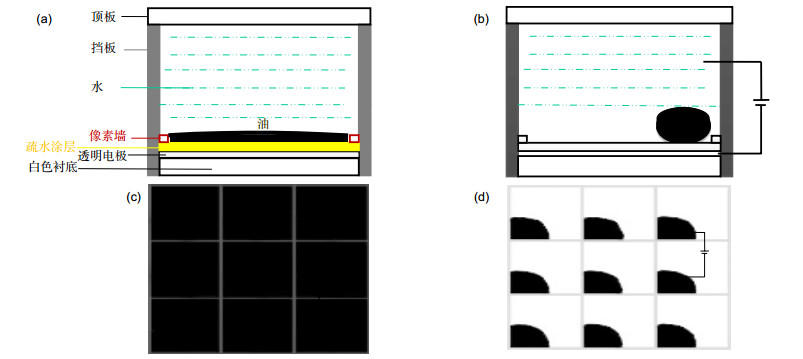
 下载:
下载:
